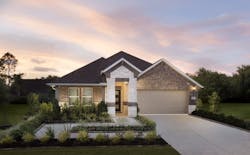Meritage Homes’ Five-Step Plan To Deliver Affordable Homes to the Masses
Steven J. Hilton used to think that building spec homes was a losing proposition. “I believed you couldn’t make money selling a lower-price product and running a volume business,” he told Dean Wehrli for the New Home Insights Podcast in August.
What does he say of that view now? “Absolutely not true.”
In January 2021, Hilton will retire as CEO (but remain executive chairman) of the company he co-founded in 1985. In its 35 years, Meritage Homes, based in Scottsdale, Ariz., has built about 135,000 houses in nine Sun Belt states. Today it’s the ninth largest builder in the nation, according to Pro Builder’s 2020 Housing Giants rankings.
Here are five insights Hilton shared with Wehrli on how Meritage Homes delivers affordable homes.
#1: Pick a lane.
Early on, Meritage built across the home spectrum: entry level, first move-up, second move-up, luxury, active adult. While Meritage made money, Hilton felt his company was just okay as a builder of many home types, but not remarkable in any one of them.
“We really felt like we weren’t great at any of it. We did a pretty good job,” Hilton said. But he and his company wanted to set its sights higher than “pretty good.” “We wanted to be an exceptional company,” he said. “We wanted to be a leader.”
To accomplish that, Meritage decided that, rather than trying to be all things to all people, it had to narrow and hone its focus. So it zeroed in on the entry-level and first move-up market. “It’s a lot easier to build entry-level homes where you don’t have to process a lot of customer changes and upgrades,” Hilton said.
“It’s really paid big dividends for us,” Hilton said of his company’s strategic shift. But it required business discipline, a streamlined and value-engineered product, and a willingness to have less product overall. “You have to convince yourself that less is more,” Hilton said.
#2: Build it, and they will come.
About two-thirds of Meritage homes are move-in-ready homes built before they’re purchased. “We don’t sell homes, we sell our existing inventory,” Hilton said. The other third of Meritage’s stock is first move-up product—larger homes that people buy after their starter homes.
— Steven J. Hilton, chairman and CEO, Meritage Homes
This year, Meritage’s spec model proved to be exactly what the market ordered.
With historically low interest rates, and a springtime spike in interest among urbanites to leave the city (though that has since tapered off), more people wanted to own suburban single-family homes, Hilton found. They wanted to feel safer, and that meant having more space. “It’s driving demand really like I’ve never seen before in my entire career,” Hilton said.
As the homeownership rate reached 67.9 percent in the second quarter of 2020, up 3.8 points from the second quarter of last year, Meritage’s stocked inventory allowed it to sell homes quickly to people who wanted to buy quickly. “The fact we had spec home inventory allowed us to capture sales … that other builders weren’t able to capitalize on,” Hilton said.
Although Meritage’s sales fell at the start of the pandemic—March and April sales dropped 8 and 15 percent, respectively, from the same months last year—business has since soared. Sales shot up by 44 percent in May and 66 percent in June.
#3: Snap up land.
“Our land strategy is to go out and develop our own land,” Hilton says.
Meritage might buy 100 acres of land and build 300 or 400 homes on it—without having to worry about competitors building across the street. Here, too, Meritage’s spec strategy pays off: “When your product is very efficient to build and you can build homes for less cost than your competition, then you can be more aggressive in buying land,” Hilton said.
That efficiency has led Meritage to accumulate $3.5 billion in assets, with $1 billion in debt. And it’s helped Meritage amass plenty of capital to buy up even more land: “We’re sitting on a cash pile of almost half a billion dollars,” Hilton said.
Even during the pandemic, Meritage kept its focus on its land-purchasing strategy: “We bought many land deals that other builders dropped,” Hilton said.
For Hilton, taking on the risks of buying land and land entitlement is “the secret of what the largest American builders do,” he said.
#4: Don’t chase the latest trend.
Meritage builds not only affordable homes but healthy, energy-efficient houses constructed with sustainable materials. “That’s been our trademark for more than a decade now,” Hilton says.
But that doesn’t mean Meritage outfits its homes with all the latest gadgets. “If you put things in your homes that you think are trendy or cool but your customers don’t value them, you’re just giving away your profits,” he says.
A small-ticket object can have a big impact: A $50 item placed in 10,000 homes adds up fast. “So we consumer test every single thing we put into our homes,” Hilton said.
#5. Embrace virtual.
Over two months this summer, Meritage had more than 1 million views of its online store—a company record. With virtual tours on the rise, Meritage saves on constructing actual homes for people to tour. “We’re building less models because the visual presentation is so real today,” Hilton said.
And for those prospective buyers who do want to see their future home in person, Meritage’s spec strategy means they can tour a physical model and see exactly what they will purchase and how they will live.
RELATED: See UTOPIA’s six-part special report on profiting with virtual sales and design centers
Builders Go Virtual to Keep Sales Humming During the Pandemic
Virtual Sales Centers: What’s the Role of Home Sales and Design Professionals?
To-Do List for Getting Started with Virtual Selling and Designing
Watch: How Roomored’s 3D Design Online is Virtualizing the Design Center Experience
